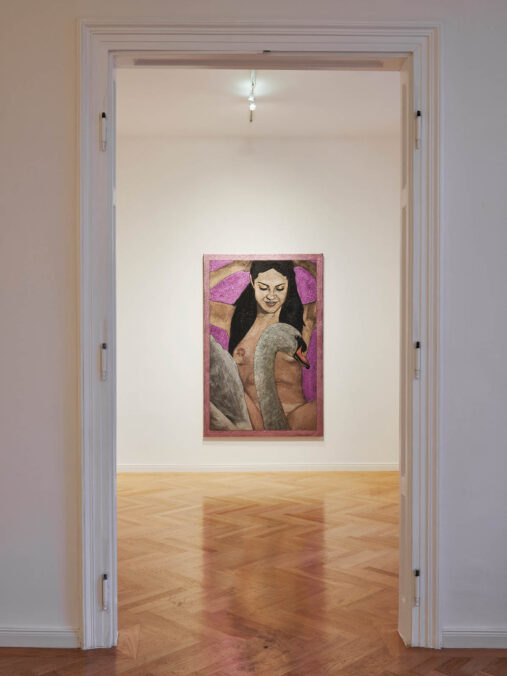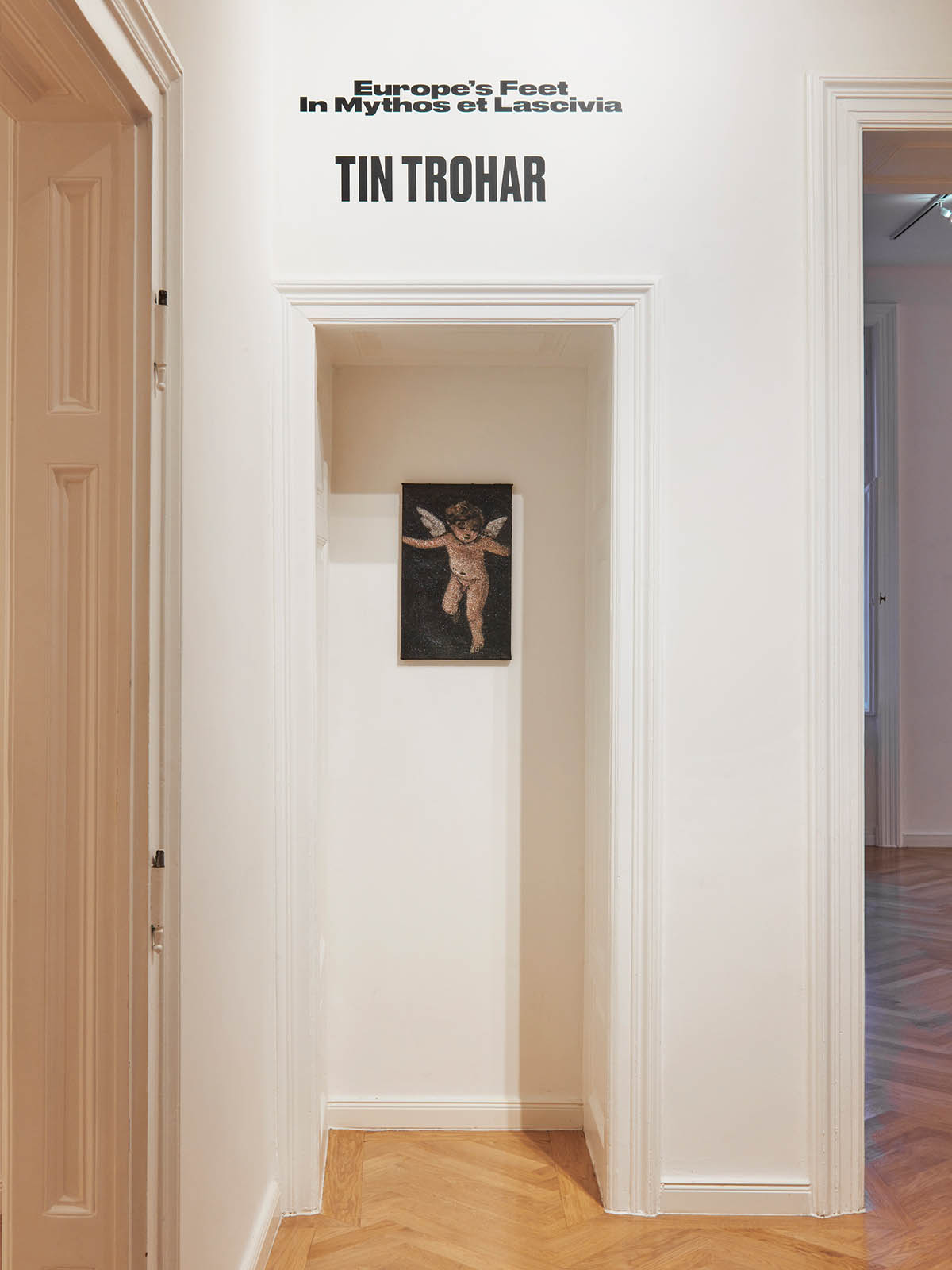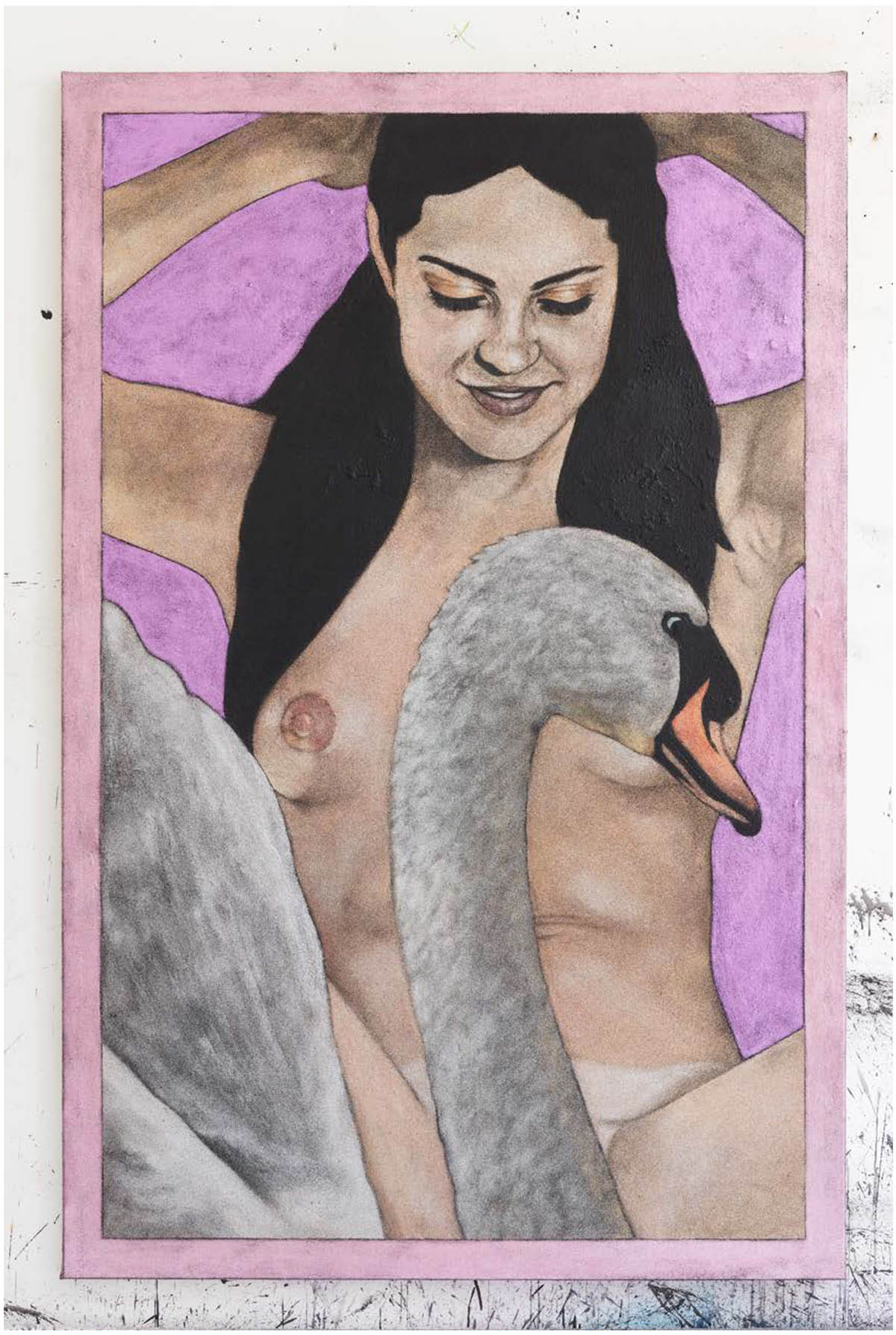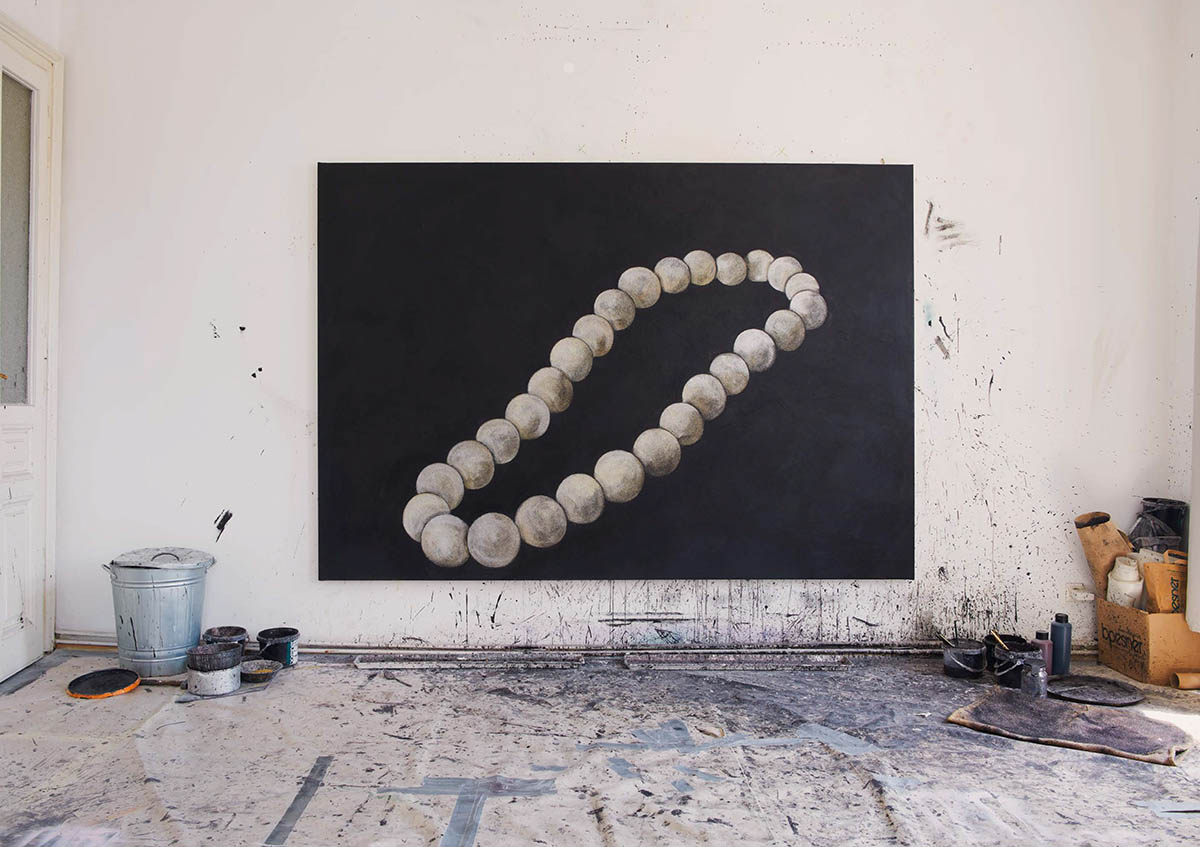
Through Trohar’s unique artistic lens, viewers are invited to reconsider the traditional portrayals of these myths, reflecting on their lasting impact on contemporary understandings of sexuality and power dynamics.
Medium and Method
Trohar’s choice of medium—acrylics and glitter on burlap—plays a significant role in conveying the themes of his work. The use of burlap, a rough and coarse fabric, juxtaposed with the shimmering elegance of glitter, mirrors the dual nature of the myths themselves: the raw, often harsh realities of the stories and the idealized, divine beauty they depict. This combination creates a textured and layered narrative, inviting viewers to explore beyond the surface.
The indirect method of depiction, focusing on negative presence, allows Trohar to subtly address themes of consent and power. By leaving spaces and using reduced and minimal forms and motifs, he invites viewers to fill in the gaps, thereby engaging them in a deeper contemplation of the underlying issues.



Leda and the Swan: Power and Vulnerability
The myth of Leda and the Swan is one of the most famous tales of divine seduction in Greek mythology. According to the myth, Zeus, the king of the gods, transformed into a swan to seduce or, as some versions suggest, to assault Leda, the queen of Sparta. The story has been depicted countless times in art and literature, often focusing on the beauty and grace of the swan and the serene acceptance of Leda.
Trohar’s rendition, however, brings a different perspective. By portraying Leda’s interaction with the swan with a focus on her facial expression and body language, he emphasizes the complexity of the encounter. Is Leda a willing participant, or is she a victim of divine coercion? This ambiguity raises important questions about consent, especially in the context of unequal power dynamics.
The use of glitter in the painting adds a layer of surreal beauty, which contrasts with the rough texture of the burlap, symbolizing the duality of the situation—beauty intertwined with violence, consent overshadowed by coercion. This duality encourages viewers to question the romanticized versions of such myths and to consider the real implications of power and vulnerability in relationships.

Venus’ Pearls: The Essence of Erotic Allure
Venus the goddess of love, beauty, and desire, is a central figure in ancient mythology’s exploration of eroticism. Trohar’s “Pearls” is a symbolic composition that captures the essence of this goddess through her iconic symbols— her pearl necklace. The pearls, often associated with purity and beauty, in this context, symbolize the allure and seduction that Venus embodies. Trohar’s use of glitter on the pearls enhances their visual appeal, making them almost tangible, yet their placement on the coarse burlap serves as a reminder of the underlying harshness of such beauty standards. This contrast invites viewers to question the nature of adornment and its role in erotic attraction. Are these symbols of beauty empowering, or do they serve to objectify and commodify the female form?
The indirect portrayal of Venus herself, through one of her attributes, allows Trohar to focus on the element that defines erotic allure without objectifying the goddess. This method of depiction aligns with contemporary critiques of beauty and desire, questioning how such attributes influence perceptions of femininity and sexual attraction. in glitter to emphasize their allure.

Trohar’s indirect approach, focusing on the necklace rather than Venus herself, allows for a critique of how beauty standards are constructed and perpetuated. The absence of the goddess in the depiction shifts the focus to the cultural significance of such symbols and their impact on perceptions of femininity and desire.
Europa’s Feet
The myth of Europa’s abduction by Zeus, who took the form of a bull, is another tale that intertwines divine desire with mortal vulnerability. In this story, Europa, a Phoenician princess, is seduced and carried away by Zeus, who is captivated by her beauty.
Trohar’s focus on Europa’s feet is a unique approach that grounds the myth in a very human and relatable element. Feet, often overlooked in artistic depictions, become a symbol of the journey, both physical and metaphorical, that Europa undergoes. This piece raises important questions about consent and agency. Europa’s feet, poised as if in motion, suggest a journey that is not entirely of her choosing. The negative space around her feet highlights the absence of her agency, inviting viewers to contemplate the implications of such abductions in myth and their relevance to modern discussions of consent.
Concomitantly Trohar also touches upon the erotic aspect of feet: in mythology, the abduction of Europe is typically depicted with grandiose scenes focusing on the bull and the princess. By choosing ton focus solely on Europa’s feet, Trohar highlights the sensual and intimate aspects of this body part, which can evoke strong feelings of desire and fetishistic fascination. The signature use of glitter enhances the visual allure of the feet even more, making them the focal point of erotic attraction. Here Trohar juxtaposes modern concepts of erotica with ancient imaginary expanding on the possible understanding of the myth.

Amor: The Playful and Unpredictable Nature of Love
Amor, or Cupid, the god of love, is often depicted as a playful and mischievous figure. In Trohar’s “Amor,” the depiction of the god of love captures this dual nature. The painting portrays Amor in a childlike form, highlighting the innocence and unpredictability of love and desire.The glitter adds a touch of magic and fantasy, while the burlap background serves as a reminder of the rough realities of love. This duality reflects the complexities of erotic desire, which can be both enchanting and troubling. Amor’s playful nature is underscored by the indirect depiction, inviting viewers to consider the unpredictable and often uncontrollable aspects of love and attraction.
Love, Lust, and Consent in Mythology
The myths depicted in Trohar’s work are not just tales of divine beauty and erotic allure but also stories that explore the darker aspects of desire, power, and consent. In ancient mythology, the gods often exert their will over mortals, raising questions about the nature of consent and the boundaries of love and lust. The abduction of Europa and the seduction of Leda are prime examples of how divine desire often overrides mortal agency. These stories, while celebrated for their beauty and allure, also highlight the power imbalances inherent in such relationships. Trohar’s work invites viewers to reexamine these myths through a contemporary lens, questioning the romanticization of non-consensual encounters and considering their implications for modern understandings of sexuality and power.
Trohar’s indirect method of depiction, focusing on negative presence, is a powerful tool in addressing these complex themes. By leaving spaces and using reduced, almost abstracted forms, he allows viewers to fill in the gaps, engaging them in a deeper contemplation of the narratives. This approach mirrors the elusive nature of consent in many of these myths, where the boundaries between desire and coercion are often blurred. The negative space in Trohar’s paintings becomes a metaphor for the unspoken and unseen aspects of these myths. It highlights what is absent—the voices of the mortals, their agency, and their consent. This method not only adds depth to the visual narrative but also invites a critical examination of the myths themselves.
Conclusio
„Europe’s Feet: In Mythos et Lascivia“ is more than an exhibition of erotic mythology; it is a thought-provoking exploration of love, lust, and consent in ancient narratives. The indirect approach and focus on negative presence challenge traditional interpretations, highlighting the complexities and darker aspects of these tales. By reexamining the myths of Leda, Europa, Venus, and Amor, Trohar’s work prompts viewers to consider the enduring impact of these narratives on contemporary discussions of sexuality and power dynamics. This exhibition not only celebrates the beauty and allure of these ancient stories but also critically examines their implications, making „Europe’s Feet: In Mythos et Lascivia“ a timely and relevant exploration of erotic mythology in the modern age.
Exhibition: Tin Trohar „Europe’s Feet: In Mythos et Lascivia“ – An Exploration of Erotic Mythology, Love, Lust, and Consent. Curated by Anne-Marie Avramut
Exhibition duration: August 8 – September 6, 2024
Opening: Thursday, August 8, 6pm
Address and contact:
Galerie Michael Bella
Maria-Theresien-Straße 30 / 14, 1010 Vienna
www.galeriemichaelbella.com





